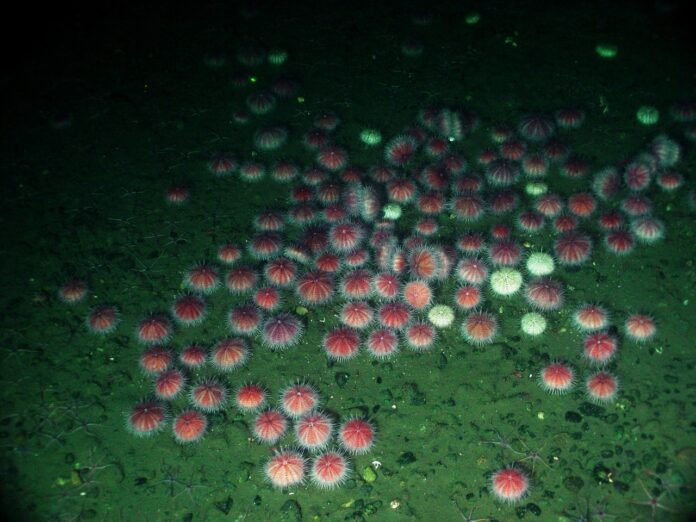Sea urchins are one of the most beautiful and interesting marine animals. They come in various colors, including purple, red, yellow, green, violet, and even orange. Despite their beauty, sea urchins can be dangerous to humans, especially the flower urchin, whose poison is potentially deadly.
Sea Urchins Are Dangerous to Humans
The flower urchin, found in the Indian and Western Pacific Oceans, is particularly hazardous. Although it has short and blunt spines, its venom, containing peditoxin, can cause anaphylactic shock, convulsions, and even death.
If a person or animal steps on a sea urchin or touches it, its spines can penetrate the flesh, causing intense pain and potential infection. Some people may have allergic reactions to the venom, leading to severe outcomes.
Interesting Facts About Sea Urchins:
1. Modern science knows about the existence of approximately 950 species of sea urchins worldwide. These animals can live at depths of up to 5 kilometers. Most sea urchins have a diameter of about 7 centimeters.
2. Sea urchins have a characteristic appearance. They have a rigid, usually spherical body enclosed in a hard protective shell surrounded by spines. As larvae, sea urchins exhibit bilateral symmetry, meaning you can divide their bodies into two halves that mirror each other. However, as adults, they develop pentaradial symmetry, meaning you can divide their bodies into five parts, which again will mirror each other.
3. Most sea urchins inhabit warm ocean water near coral reefs or algae beds on rocky bottoms. These beautiful balls have teeth made of calcium carbonate. Each tooth has its own jaw, located in a circle at the center of the body.
4. Sea urchins are omnivorous. Their main food source consists of algae, whether phytoplankton or more complex forms of algae. However, they supplement their diet with meat, usually sea cucumbers. They also hunt other animals such as sea stars, sponges, various mollusks, and even worms.
5. These echinoderms move using tube feet—flexible appendages that rapidly enter and exit holes. Urchins use the internal pressure of their bodies to make them move. As their feet begin to slide in and out, they push the rest of their bodies, causing the urchin to roll along the seabed. Since sea urchin tube feet and spines are very similar, it’s not surprising that people often confuse them. This creates the illusion that the sea urchin uses its spines for movement.
6. Scientists call the mouth of a sea urchin Aristotle’s lantern. This name was given in honor of the Greek philosopher and scientist Aristotle, who described the mouth of a sea urchin in his book “The History of Animals.” In particular, he compared its mouth to a lantern with the glasses removed. However, it was later discovered that this was a mistranslation of Aristotle’s works. Scientists now claim that Aristotle actually described the sea urchin as a whole, comparing it to lamps used in Greece at the time. However, the term “Aristotle’s lantern” is still used by scientists to refer to the mouth of a sea urchin.
7. Surprisingly, sea urchins dislike light and actively move away from its source. Scientists believe that this behavior could be the result of evolutionary adaptation, as urchins actively avoid predators.
8. Sea urchins can be susceptible to various diseases. Scientists are still debating whether disease outbreaks among sea urchins are a natural occurrence or a side effect of human development. Scientists first became interested in this issue in the 1980s when the first recorded outbreak of mass sea urchin disease occurred.
9. Sea urchins have many enemies. Among them are crabs, lobsters, otters, and various species of fish that have the ability to bypass the sea urchin’s defenses. Crabs and lobsters crush the urchin’s spines with their claws before tearing it apart. Predatory fish simply bite them off, while otters use their claws and strength.
10. The clownfish is capable of becoming immune to the venom of the flower urchin. It briefly approaches the urchin and rubs against it with its body, allowing itself to be poisoned in small amounts. As it recovers, it develops resistance to the venom, and the clownfish rubs against the flower urchin longer and longer each time until the venom no longer affects it.
11. In Mediterranean cuisine, chefs serve sea urchin raw or prepared with lemon. They are also served as part of pasta sauce in Italian cuisine, indicated on the menu as an ingredient called “ricci”. Sea urchins are also a key ingredient in Dutch sauce and mayonnaise used in fish dishes. On the other side of the world, Chileans eat raw sea urchin seasoned with lemons, olive oil, and onions. Japanese annually consume up to 50,000 tons of sea urchin, which they call “uni”, accounting for 80% of the world’s annual sea urchin catch.
12. In addition to the urchins themselves, their eggs in Japan are a pricey delicacy: a kilogram of eggs costs 40,000 yen or 360 dollars. Japan’s high demand for sea urchins has even sparked protests from environmentalists.
13. Sea urchins make a great addition to an aquarium. The Slate Pencil sea urchin is particularly popular among marine aquarium owners. These echinoderms feed on algae, making them natural filters for the aquarium, helping to keep it clean. However, owners should be cautious, as not every aquarium fish can coexist with sea urchins.
14. Although sea urchins are generally not threatened by extinction, their population in the Mediterranean Sea has recently declined. Due to global warming, the water becomes too warm even for sea urchins, which, combined with water pollution, negatively impacts their reproduction.
